 Java
Java
 javaTutorial
javaTutorial
 How to simulate and implement Java Spring dependency injection in ABAP (picture and text)
How to simulate and implement Java Spring dependency injection in ABAP (picture and text)
How to simulate and implement Java Spring dependency injection in ABAP (picture and text)
The content of this article is about how to simulate and implement Java Spring dependency injection in ABAP (pictures and texts). It has certain reference value. Friends in need can refer to it. I hope it will be helpful to you. .
Dependency Injection- Dependency injection is widely used in the Java Spring framework. Through dependency injection, we don't have to tediously initialize dependent resources in the application code, which is very convenient.
So can ABAP also support dependency injection from the language level and enjoy the convenience brought by this design idea? Let's give it a try.
Try the scene
In real life, every light has a switch control. Press the switch and the light is turned on; press it again and the light goes out.
Let’s not look at the conventional implementation using dependency injection:
Design an ABAP interface ZIF_SWITCHABLE, providing two methods, corresponding to on and off respectively.

Naturally, I have an ABAP class ZCL_LAMP that implements the above interface. Each instance of ZCL_LAMP is a lamp.
CLASS ZCL_LAMP IMPLEMENTATION. method ZIF_SWITCHABLE~OFF. WRITE: / 'lamp off'. endmethod. method ZIF_SWITCHABLE~ON. WRITE: / 'lamp on'. endmethod. ENDCLASS.
Design a switch class. This class has a member variable mo_switchable, pointing to the ZIF_SWITCHABLE interface.

The switch has a "press" method. After pressing, if the current state is on, then call the off method of the mo_switchable member to turn it off, and set the switch state to off. vice versa.
METHOD push. IF isswitchon = abap_true. mo_switchable->off( ). isswitchon = abap_false. ELSE. mo_switchable->on( ). isswitchon = abap_true. ENDIF. ENDMETHOD.
Provide a setter method to inject the passed variable of type ZIF_SWITCHABLE into the member variable mo_switchable.
method SET_SWITCHABLE. mo_switchable = io_switchable. endmethod.
I put the two classes created so far: ZCL_LAMP and ZCL_SWITCH into package $ZDEV_INVERSION.
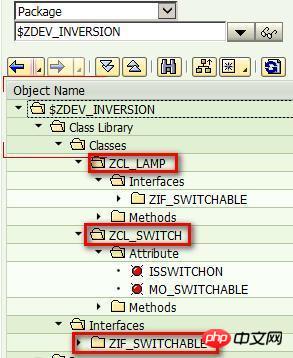
Consumption code of the ABAP Summer framework
As can be seen from the code below, ZCL_SWITCH and ZCL_LAMP creates a strong dependency. This dependency is manually injected by the application developer by calling the set method.
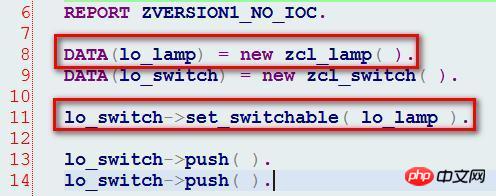
To summarize, which of the codes in the above figure can be completely avoided in Java Spring through the idea of dependency injection.
line 8: Manually create an instance of ZCL_LAMP (light).
line 9: Manually create an instance of ZCL_SWITCH (switch).
Line 11: Call the set method to manually inject the dependencies of lights and switches.
Using the ABAP Summer framework to implement dependency injection
I used ABAP to simulate the Java Spring dependency injection framework, and developed a prototype named ABAP Summer, which is compatible with Java Spring echoes.
First think about how to implement this simple example with Java Spring. A Java programmer can easily write the following code. Using Spring's @Inject annotation, we do not need to manually instantiate ISwitchable and call the set method to establish dependencies. Everything is implemented by the Spring framework for us.
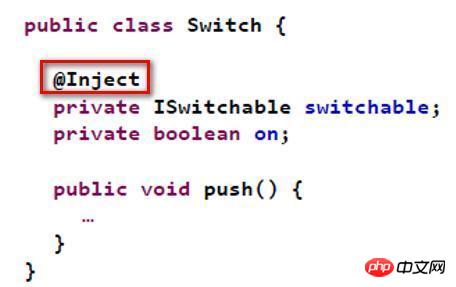
Now, how to use ABAP to achieve these "magic"?
1. Add the annotation @Inject in the description field of the member variable mo_switchable of the ZCL_SWITCH class. The purpose is to tell the ABAP Summer framework that I hope that the mo_switchable member can automatically be injected with a correct dependency. What kind of dependency is correct? How does the Summer framework know how to inject? Please read on.

Note: The ABAP language is different from Java and cannot support annotations at the language level, so the @Inject maintained on the Description field here is just one simulation.
2. Let’s first look at the ABAP consumption code after using dependency injection. Does it feel a lot cleaner all of a sudden?
data(summer) = zcl_summer=>get_instance( ). data(lo_switch) = cast zcl_switch( summer->get_bean( EXPORTING iv_bean_name = 'ZCL_SWITCH' ) ). lo_switch->push( ). lo_switch->push( ).
The following figure is a comparison of two sets of consumption codes based on ABAP conventional implementation and ABAP dependency injection idea. It can be clearly found that after ABAP dependency injection is adopted,

The three manual operations mentioned before are completely avoided. The member variable mo_switchable in the switch instance returned by the GET_BEAN method contains the automatically injected instance of the ZCL_LAMP class.
line 8: Manually create an instance of ZCL_LAMP (light).
line 9: Manually create an instance of ZCL_SWITCH (switch).
Line 11: Call the set method to manually inject the dependencies of lights and switches.
Let us take another look at the authentic consumption code in Java Spring to ensure that the ABAP Summer we invented is indeed the original dependency injection.
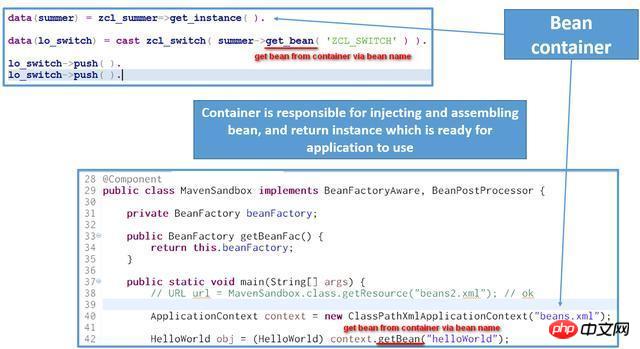
The implementation principle of ABAP Summer dependency injection
The implementation of this ABAP dependency injection framework is in my On github:
https://github.com/i042416/je...

About Java Spring dependency injection Explain, there are many wonderfully written books on the Internet.

The following is the core implementation of ABAP Summer dependency injection, refer to the explanation of Java Spring in the book above.
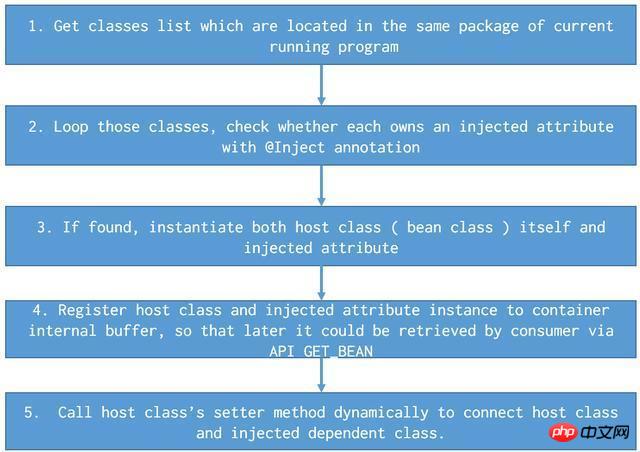
The above is the detailed content of How to simulate and implement Java Spring dependency injection in ABAP (picture and text). For more information, please follow other related articles on the PHP Chinese website!

Hot AI Tools

Undresser.AI Undress
AI-powered app for creating realistic nude photos

AI Clothes Remover
Online AI tool for removing clothes from photos.

Undress AI Tool
Undress images for free

Clothoff.io
AI clothes remover

Video Face Swap
Swap faces in any video effortlessly with our completely free AI face swap tool!

Hot Article

Hot Tools

Notepad++7.3.1
Easy-to-use and free code editor

SublimeText3 Chinese version
Chinese version, very easy to use

Zend Studio 13.0.1
Powerful PHP integrated development environment

Dreamweaver CS6
Visual web development tools

SublimeText3 Mac version
God-level code editing software (SublimeText3)

Hot Topics
 Break or return from Java 8 stream forEach?
Feb 07, 2025 pm 12:09 PM
Break or return from Java 8 stream forEach?
Feb 07, 2025 pm 12:09 PM
Java 8 introduces the Stream API, providing a powerful and expressive way to process data collections. However, a common question when using Stream is: How to break or return from a forEach operation? Traditional loops allow for early interruption or return, but Stream's forEach method does not directly support this method. This article will explain the reasons and explore alternative methods for implementing premature termination in Stream processing systems. Further reading: Java Stream API improvements Understand Stream forEach The forEach method is a terminal operation that performs one operation on each element in the Stream. Its design intention is
 Java Program to Find the Volume of Capsule
Feb 07, 2025 am 11:37 AM
Java Program to Find the Volume of Capsule
Feb 07, 2025 am 11:37 AM
Capsules are three-dimensional geometric figures, composed of a cylinder and a hemisphere at both ends. The volume of the capsule can be calculated by adding the volume of the cylinder and the volume of the hemisphere at both ends. This tutorial will discuss how to calculate the volume of a given capsule in Java using different methods. Capsule volume formula The formula for capsule volume is as follows: Capsule volume = Cylindrical volume Volume Two hemisphere volume in, r: The radius of the hemisphere. h: The height of the cylinder (excluding the hemisphere). Example 1 enter Radius = 5 units Height = 10 units Output Volume = 1570.8 cubic units explain Calculate volume using formula: Volume = π × r2 × h (4
 PHP vs. Python: Understanding the Differences
Apr 11, 2025 am 12:15 AM
PHP vs. Python: Understanding the Differences
Apr 11, 2025 am 12:15 AM
PHP and Python each have their own advantages, and the choice should be based on project requirements. 1.PHP is suitable for web development, with simple syntax and high execution efficiency. 2. Python is suitable for data science and machine learning, with concise syntax and rich libraries.
 PHP: A Key Language for Web Development
Apr 13, 2025 am 12:08 AM
PHP: A Key Language for Web Development
Apr 13, 2025 am 12:08 AM
PHP is a scripting language widely used on the server side, especially suitable for web development. 1.PHP can embed HTML, process HTTP requests and responses, and supports a variety of databases. 2.PHP is used to generate dynamic web content, process form data, access databases, etc., with strong community support and open source resources. 3. PHP is an interpreted language, and the execution process includes lexical analysis, grammatical analysis, compilation and execution. 4.PHP can be combined with MySQL for advanced applications such as user registration systems. 5. When debugging PHP, you can use functions such as error_reporting() and var_dump(). 6. Optimize PHP code to use caching mechanisms, optimize database queries and use built-in functions. 7
 Open Intents: Can ERC-7683 become a 'Walmart' supermarket with the intention of synergy between Ethereum chains?
Mar 04, 2025 pm 06:24 PM
Open Intents: Can ERC-7683 become a 'Walmart' supermarket with the intention of synergy between Ethereum chains?
Mar 04, 2025 pm 06:24 PM
Written by YBBCapital ResearcherAc-Core: Ethereum fragmentation problem and OpenIntents framework: ERC-7683's breakthrough method Source: @ethereumfndnL2 and the booming development of DeFi have led to the increasing fragmentation of Ethereum liquidity. Asset liquidity is scattered among L1 and many L2s, and there is a lack of effective interconnection between various platforms, like isolated "small pools", hindering the overall efficiency of Ethereum. In 2024, Ethereum added more than 100 new chains, which is like a large shopping mall with a wide range of products, but it requires settlement in different currencies. To solve this problem, the Ethereum Foundation released OpenIntentsF on February 20
 How to Run Your First Spring Boot Application in Spring Tool Suite?
Feb 07, 2025 pm 12:11 PM
How to Run Your First Spring Boot Application in Spring Tool Suite?
Feb 07, 2025 pm 12:11 PM
Spring Boot simplifies the creation of robust, scalable, and production-ready Java applications, revolutionizing Java development. Its "convention over configuration" approach, inherent to the Spring ecosystem, minimizes manual setup, allo
 PHP vs. Other Languages: A Comparison
Apr 13, 2025 am 12:19 AM
PHP vs. Other Languages: A Comparison
Apr 13, 2025 am 12:19 AM
PHP is suitable for web development, especially in rapid development and processing dynamic content, but is not good at data science and enterprise-level applications. Compared with Python, PHP has more advantages in web development, but is not as good as Python in the field of data science; compared with Java, PHP performs worse in enterprise-level applications, but is more flexible in web development; compared with JavaScript, PHP is more concise in back-end development, but is not as good as JavaScript in front-end development.
 PHP vs. Python: Core Features and Functionality
Apr 13, 2025 am 12:16 AM
PHP vs. Python: Core Features and Functionality
Apr 13, 2025 am 12:16 AM
PHP and Python each have their own advantages and are suitable for different scenarios. 1.PHP is suitable for web development and provides built-in web servers and rich function libraries. 2. Python is suitable for data science and machine learning, with concise syntax and a powerful standard library. When choosing, it should be decided based on project requirements.





